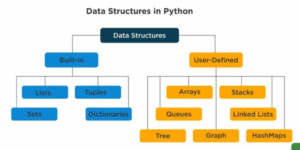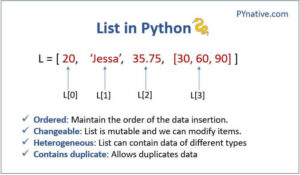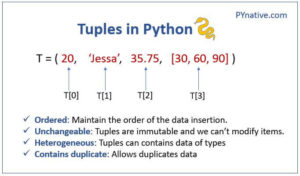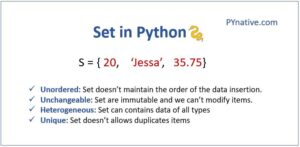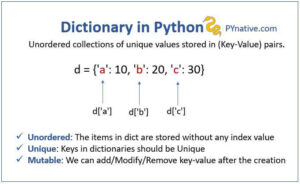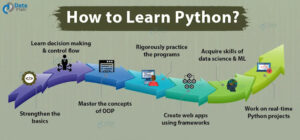WHAT IS DATA STRUCTURES IN PYTHON?
Python, a high-level programming language renowned for its adaptability, has emerged as a favourite among developers across various domains. With its clean syntax and extensive standard library, Python offers an ideal platform for implementing data structures.
These structures serve as the building blocks for organizing and manipulating data efficiently, essential for solving complex computational problems.
Data structures in Python refer to the ways data is organized and stored, facilitating efficient manipulation and retrieval. Python’s extensive standard library offers built-in data structures like lists, dictionaries, sets, and tuples, each tailored for specific tasks.
Understanding data structures in Python is crucial for optimizing performance and designing elegant solutions to complex problems. In this guide, we’ll delve into the intricacies of data structures in Python, uncovering their significance in modern programming practices.
DATA STRUCTURES IN PYTHON
Built-in data structures in Python can be divided into two broad categories: mutable and immutable. Mutable data structures are those that we can modify — for example, by adding, removing, or changing their elements.
Python has three mutable data structures: lists, dictionaries, and sets. Immutable data structures, on the other hand, are those that we cannot modify after their creation. The only basic built-in immutable data structure in Python is a tuple.
Python also has some advanced data structures, such as stacks, queues, trees, and graphs which can be implemented with these basic data structures.
BUILT-IN DATA STRUCTURES IN PYTHON
1. LISTS
In Python, lists are one of the most versatile and commonly used data structures. A list is an ordered collection of elements, where each element is identified by its position or index. Lists in Python are mutable, meaning they can be modified after creation, allowing for dynamic manipulation of data.
Key Characteristics of Lists:
Ordered Collection: Lists maintain the order of elements as they are inserted. This enables sequential access to elements based on their position in the list.
Mutable: Unlike some other data structures like tuples, lists in Python are mutable, meaning elements can be added, removed, or modified after the list is created.
Heterogeneous Elements: Lists can contain elements of different data types, including integers, strings, floats, and even other lists. This flexibility allows for the construction of complex data structures within a single list.
Syntax:
Creating a list in Python is straightforward. Elements are enclosed within square brackets ` [] `, separated by commas. Here’s an example:
my_list = [1, 2, 3, ‘hello’, 5.5]
List operations:
Indexing and Slicing: Elements in a list can be accessed using their index. Slicing allows extracting a sub-list by specifying a range of indices.
Appending and Extending: Elements can be added to the end of a list using the `append()` method. The `extend()` method is used to add multiple elements from another iterable to the end of the list.
Inserting and Removing Elements: The `insert()` method allows inserting an element at a specified position in the list. Elements can be removed using methods like `remove()` and `pop()`.
2. TUPLES
Tuples are another fundamental data structure in Python, often compared to lists due to their similarities, yet they possess distinct characteristics. A tuple is an ordered collection of elements, similar to a list, but with one critical difference: tuples are immutable, meaning that once created, their elements cannot be changed or modified.
Key Characteristics of Tuples:
Ordered Collection: Tuples maintain the order of elements as they are inserted. This property ensures that elements can be accessed sequentially based on their position in the tuple.
Immutable: Tuples in Python are immutable, meaning their contents cannot be altered after creation. While this restricts dynamic manipulation, it provides benefits such as safer data storage and enhanced performance.
Heterogeneous Elements: Tuples, can contain elements of different data types, offering versatility in representing diverse data structures within a single tuple.
Syntax:
Creating a tuple in Python is simple using parentheses ( ). Elements are separated by commas. Here’s an example:
my_tuple = (1, 2, 3, ‘hello’, 5.5)
Tuple Operations:
Indexing and Slicing: Similar to lists, elements in a tuple can be accessed using their index. Slicing allows extracting a subset of elements by specifying a range of indices.
Tuple Packing and Unpacking: Tuples support packing multiple values into a single tuple and unpacking values from a tuple into individual variables, providing a convenient way to handle multiple return values from functions.
3. SETS
In Python, sets are a versatile and powerful data structure used for storing unique elements. Unlike lists or tuples, which are ordered collections, sets are unordered, meaning they do not maintain the order of elements as they are inserted.
Sets are particularly useful for tasks that involve testing membership, eliminating duplicate entries, and performing mathematical operations like union, intersection, and difference.
Key Characteristics of Sets:
Unordered Collection: Sets do not maintain the order of elements as they are inserted. This lack of ordering means that sets are not indexable and do not support operations like indexing and slicing.
Unique Elements: Sets only contain unique elements. If an element is already present in the set, subsequent attempts to add it will have no effect, ensuring that each element appears only once in the set.
Mutable: Like lists and dictionaries, sets in Python are mutable, meaning elements can be added or removed after the set is created. This allows for dynamic manipulation of set contents.
Syntax:
Creating a set in Python is straightforward. Elements are enclosed within curly braces `{ }`, separated by commas. Here’s an example:
my_set = {1, 2, 3, ‘hello’, 5.5}
Alternatively, you can create a set from an existing iterable, such as a list, using the `set()` constructor:
my_list = [1, 2, 3, 3, 4]
my_set = set(my_list) # Results in {1, 2, 3, 4}
Set Operations:
Membership Testing: Sets are efficient for testing membership, i.e., checking whether a particular element is present in the set or not.
Adding and Removing Elements: Elements can be added to a set using the `add()` method and removed using methods like `remove()` and `discard()`.
Set Operations: Sets support various mathematical operations, including union, intersection, difference, and symmetric difference, providing powerful tools for set manipulation and analysis.
4. DICTIONARIES
In Python, dictionaries are versatile data structures used for storing key-value pairs. Unlike sequences such as lists and tuples, which are indexed by a range of numbers, dictionaries are indexed by keys, allowing for fast retrieval of values based on their associated keys.
Key Characteristics of Dictionaries:
Key-Value Pairs: Dictionaries consist of key-value pairs, where each key is associated with a corresponding value. This key-value mapping enables efficient retrieval of values based on their keys.
Unordered Collection: Dictionaries do not maintain the order of elements. While keys within a dictionary have a specific order, this order is not guaranteed and should not be relied upon.
Mutable: Like lists and sets, dictionaries in Python are mutable, allowing for dynamic manipulation of key-value pairs. Elements can be added, modified, or removed from a dictionary after it is created.
Syntax:
Creating a dictionary in Python involves specifying key-value pairs within curly braces `{ }`, separated by commas and with each key-value pair separated by a colon `:`. Here’s an example:
my_dict = {‘name’: ‘John’, ‘age’: 30, ‘city’: ‘New York’}
Alternatively, dictionaries can be created using the `dict()` constructor by passing in an iterable of key-value pairs:
my_dict = dict([(‘name’, ‘John’), (‘age’, 30), (‘city’, ‘New York’)])
Dictionary Operations:
Accessing Values: Values in a dictionary can be accessed using their corresponding keys. If a key is not present in the dictionary, an error may occur. To avoid errors, the `get()` method can be used, which returns `None` if the key is not found.
Adding and Updating Values: New key-value pairs can be added to a dictionary using assignment. If a key already exists in the dictionary, its value can be updated by reassigning it.
Removing Key-Value Pairs: Key-value pairs can be removed from a dictionary using the `del` keyword or the `pop()` method.
CUSTOM DATA STRUCTURES
Custom data structures in Python allow programmers to create specialized data structures tailored to specific needs or requirements beyond the built-in options. These custom structures offer flexibility and efficiency in managing complex data and solving unique problems. Python’s object-oriented nature facilitates the creation of custom data structures through classes and encapsulation.
Types of Custom Data Structures in Python:
1. Linked Lists: Linked lists are linear data structures consisting of nodes connected by pointers. They offer efficient insertion and deletion operations, making them suitable for dynamic data storage.
2. Trees: Trees are hierarchical data structures composed of nodes, typically with a root node and child nodes. They are used for organizing and representing hierarchical relationships, such as file systems and organizational charts.
3. Graphs: Graphs consist of vertices (nodes) connected by edges. They are versatile data structures used to model relationships between entities in various applications, such as social networks and transportation networks.
4. Heaps: Heaps are specialized tree-based data structures used for priority queue implementations. They ensure efficient retrieval of the highest (or lowest) priority element.
5. Hash Tables: Hash tables are data structures that store key-value pairs, providing fast access to values based on their associated keys. They are commonly used in implementing dictionaries and database indexing.
FAQS ON WHAT IS DATA STRUCTURE IN PYTHON
Q1. What are data structures in Python?
Ans. Data structures in Python refer to the ways data is organized and stored, facilitating efficient manipulation and retrieval.
Q2. What are the characteristics of lists in Python?
Ans. Lists in Python are ordered collections of elements, mutable, and can contain heterogeneous elements.
Q3. What is the syntax for creating a list in Python?
Ans. Elements are enclosed within square brackets `[ ]`, separated by commas.
Q4. What operations can be performed on lists in Python?
Ans. Operations include indexing, slicing, appending, extending, inserting, and removing elements.
Q5. What are the key characteristics of tuples in Python?
Ans. Tuples are ordered, immutable, and can contain heterogeneous elements.
Q6. What is the syntax for creating a set in Python?
Ans. Elements are enclosed within curly braces `{ }`, separated by commas.
Q7. What are dictionaries in Python?
Ans. Dictionaries are versatile data structures used for storing key-value pairs, mutable, and unordered.
CONCLUSION
Hence, understanding the diverse range of data structures available in Python is crucial for crafting efficient and scalable programs. These structures form the foundation of programming, dictating how data is organized and manipulated. Throughout this guide, we’ve delved into the significance of data structures, emphasizing their pivotal role in programming endeavors.
By exploring Python’s built-in data structures, we’ve gained insight into their characteristics and utility in various scenarios. Furthermore, we’ve illustrated the process of crafting custom data structures in Python, showcasing the language’s adaptability and versatility to cater to specific needs.
Curious to know the importance of data structures in cracking tech interviews and building successful coding projects? Check out – Why DSA Matters: The Secret Ingredient in Successful Coding Projects.



